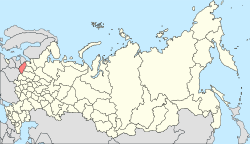Gdov
| Gdov (English) Гдов (Russian) |
|
|---|---|
| - Town - | |
 Karla Marksa Street, the main street in Gdov |
|
 Location of Pskov Oblast in Russia |
|
|
|
|
|
|
|
|
|
|
| Administrative status (as of February 2013) | |
| Country | Russia |
| Federal subject | Pskov Oblast |
| Administrative district | Gdovsky District |
| Administrative center of | Gdovsky District |
| Municipal status (as of February 2013) | |
| Municipal district | Gdovsky Municipal District |
| Urban settlement | Gdov Urban Settlement |
| Administrative center of | Gdovsky Municipal District, Gdov Urban Settlement |
| Statistics | |
| Population (2010 Census) | 4,379 inhabitants |
| Time zone | MSK (UTC+03:00) |
| First mentioned | beginning of the 14th century |
| Town status since | 1780 |
| Postal code(s) | 181600 |
| Dialing code(s) | +7 81131 |
| on | |
Gdov (Russian: Гдов; Estonian: Oudova) is a town and the administrative center of Gdovsky District in Pskov Oblast, Russia, located on the Gdovka River, just 2 kilometers (1.2 mi) from its outflow into Lake Peipus. Population: 4,379 (2010 Census);5,171 (2002 Census);6,009 (1989 Census).
It was first mentioned in the beginning of the 14th century, as an outpost guarding the city of Pskov. Between 1431 and 1434, Pskovians built a fortress there, the remains of which can still be seen. It was attacked on numerous occasions by Swedes and Poles (e.g., during the Russo–Swedish War (1590–1595) and the Ingrian War), captured by Swedes in 1614, but was finally returned to Russia in 1617 according to the Treaty of Stolbovo.
In the course of the administrative reform carried out in 1708 by Peter the Great, Gdov was included into Ingermanland Governorate (known since 1710 as Saint Petersburg Governorate). Gdov was mentioned as one of the towns into which the governorate was divided. In 1780, Gdov was granted town status; its coat of arms was granted on May 28, 1781. Between 1874 and 1912, Gdov issued Zemstvo stamps. The first stamp, worth two kopecks, appeared on April 16, 1874. Stamp production ceased, however, with the coming of World War I. In 1919, Gdov was an area where important events of the Russian Civil War and the Estonian War of Independence were taking place. Originally, the area east of Lake Peipus was under control of the revolutionary government. On May 15, 1919, the detachment under command of Stanisław Bułak-Bałachowicz (subordinate to General Aleksandr Rodzyanko) captured Gdov and the whole uyezd thus came under control by the White Army troops of Nikolai Yudenich. In November 1919, the Red Army recaptured Gdov.
...
Wikipedia


